8.4 Rotational Kinetic Energy: Work and Energy Revisited
Learning Objectives
By the end of this section, you will be able to:
- Derive the equation for rotational work.
- Calculate rotational kinetic energy.
- Demonstrate the Law of Conservation of Energy.
In this module, we will learn about work and energy associated with rotational motion. Figure 8.13 shows a worker using an electric grindstone propelled by a motor. Sparks are flying, and noise and vibration are created as layers of steel are pared from the pole. The stone continues to turn even after the motor is turned off, but it is eventually brought to a stop by friction. Clearly, the motor had to work to get the stone spinning. This work went into heat, light, sound, vibration, and considerable rotational kinetic energy.
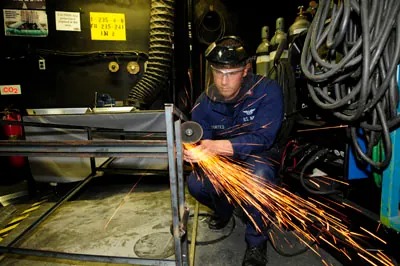
Figure 8.13 The motor works in spinning the grindstone, giving it rotational kinetic energy. That energy is then converted to heat, light, sound, and vibration. Image from OpenStax College Physics 2e, CC-BY 4.0
Work must be done to rotate objects such as grindstones or merry-go-rounds. Work was defined in Uniform Circular Motion and Gravitation for translational motion, and we can build on that knowledge when considering work done in rotational motion. The simplest rotational situation is one in which the net force is exerted perpendicular to the radius of a disk (as shown in Figure 8.14) and remains perpendicular as the disk starts to rotate. The force is parallel to the displacement, and so the net work done is the product of the force times the arc length traveled:
[latex]\text{net } W = \left(\right. \text{net } F \left.\right) \Delta s .[/latex]
To get torque and other rotational quantities into the equation, we multiply and divide the right-hand side of the equation by [latex]r[/latex], and gather terms:
[latex]\text{net} W = \left(\right. r \text{ net } F \left.\right) \frac{\Delta s}{r} .[/latex]
We recognize that [latex]r \text{ net } F = \text{ net }\tau[/latex] and [latex]Δ s / r = \theta[/latex], so that
[latex]\text{net } W = \left(\text{net }\tau\right) \theta .[/latex]
This equation is the expression for rotational work. It is very similar to the familiar definition of translational work as force multiplied by distance. Here, torque is analogous to force, and angle is analogous to distance. The equation [latex]\text{net } W = \left(\text{net }\tau\right) \theta[/latex] is valid in general, even though it was derived for a special case.
To get an expression for rotational kinetic energy, we must again perform some algebraic manipulations. The first step is to note that [latex]\text{net }\tau = Iα[/latex], so that
[latex]\text{net } W = I \alpha\theta .[/latex]
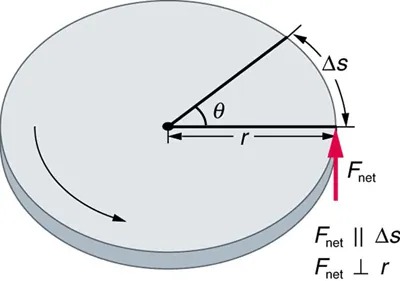
Figure 8.14 The net force on this disk is kept perpendicular to its radius as the force causes the disk to rotate. The net work done is thus [latex]\left(\text{net } F\right) Δ s[/latex]. The net work goes into rotational kinetic energy. Image from OpenStax College Physics 2e, CC-BY 4.0
Image Description
The image shows a diagram of a circular disk with an arrow indicating rotation in the counterclockwise direction. In the center of the disk, a radius labeled “r” is drawn from the center to the edge. At the tip of the radius, there is an angle labeled “θ,” and a small arc labeled “Δs” at the edge, indicating a section of the circle.
A red arrow labeled “F_net” points outward from the edge of the circle, perpendicular to the radius. This represents the net force acting on the edge of the disk.
Below the disk, there are two mathematical expressions:
1. F_net ‖ Δs
2. F_net ⊥ r
These expressions mean that the net force is parallel to the arc segment Δs and perpendicular to the radius r.
Making Connections
Work and energy in rotational motion are completely analogous to work and energy in translational motion, first presented in Uniform Circular Motion and Gravitation.
Now, we solve one of the rotational kinematics equations for [latex]\alpha\theta[/latex]. We start with the equation
[latex]\omega^{2} = \omega_{\text{0}}^{2} + 2 \alpha\theta .[/latex]
Next, we solve for [latex]\alpha\theta[/latex]:
[latex]\alpha\theta = \frac{\omega^{2} - \omega_{\text{0}}^{2}}{2} .[/latex]
Substituting this into the equation for net [latex]W[/latex] and gathering terms yields
[latex]\text{net } W = \frac{1}{2} Iω^{2} - \frac{1}{2} I \omega_{\text{0}}^{2} .[/latex]
This equation is the work-energy theorem for rotational motion only. As you may recall, net work changes the kinetic energy of a system. Through an analogy with translational motion, we define the term [latex]\left(\frac{1}{2}\right) Iω^{2}[/latex] to be rotational kinetic energy [latex]\text{KE}_{\text{rot}}[/latex] for an object with a moment of inertia [latex]I[/latex] and an angular velocity [latex]\omega[/latex]:
[latex]\text{KE}_{\text{rot}} = \frac{1}{2} Iω^{2} .[/latex]
The expression for rotational kinetic energy is exactly analogous to translational kinetic energy, with [latex]I[/latex] being analogous to [latex]m[/latex] and [latex]\omega[/latex] to [latex]v[/latex]. Rotational kinetic energy has important effects. Flywheels, for example, can be used to store large amounts of rotational kinetic energy in a vehicle, as seen in Figure 8.15.

Figure 8.15 Experimental vehicles, such as this bus, have been constructed in which rotational kinetic energy is stored in a large flywheel. When the bus goes down a hill, its transmission converts its gravitational potential energy into [latex]\text{KE}_{\text{rot}}[/latex]. It can also convert translational kinetic energy, when the bus stops, into [latex]\text{KE}_{\text{rot}}[/latex]. The flywheel’s energy can then be used to accelerate, to go up another hill, or to keep the bus from slowing down due to friction. Image from OpenStax College Physics 2e, CC-BY 4.0
Image Description
The image is a cartoon illustration of a yellow bus with multiple windows and a door at the front. The body of the bus has two horizontal black stripes. A cut-out section on the side of the bus reveals a spinning disc with an arrow on top, labeled with the Greek letter omega (ω), indicating rotation. The disc also has blue circular arrows showing the direction of spin. The bus appears to be on a grey road surface.
Example 8.8
Calculating the Work and Energy for Spinning a Grindstone
Consider a person who spins a large grindstone by placing her hand on its edge and exerting a force through part of a revolution as shown in Figure 8.16. In this example, we verify that the work done by the torque she exerts equals the change in rotational energy. (a) How much work is done if she exerts a force of 200 N through a rotation of [latex]\text{1}.\text{00 rad} \left(\right. 57.3º \left.\right)[/latex]? The force is kept perpendicular to the grindstone’s 0.320-m radius at the point of application, and the effects of friction are negligible. (b) What is the final angular velocity if the grindstone has a mass of 85.0 kg? (c) What is the final rotational kinetic energy? (It should equal the work.)
Strategy
To find the work, we can use the equation [latex]\text{net } W = \left(\text{net }\tau\right) \theta[/latex]. We have enough information to calculate the torque and are given the rotation angle. In the second part, we can find the final angular velocity using one of the kinematic relationships. In the last part, we can calculate the rotational kinetic energy from its expression in [latex]\text{KE}_{\text{rot}} = \frac{1}{2} Iω^{2}[/latex].
Solution for (a)
The net work is expressed in the equation
[latex]\text{net } W = \left(\text{net }\tau\right) \theta ,[/latex]
where net [latex]\tau[/latex] is the applied force multiplied by the radius [latex]\left(\right. \text{rF} \left.\right)[/latex] because there is no retarding friction, and the force is perpendicular to [latex]r[/latex]. The angle [latex]\theta[/latex] is given. Substituting the given values in the equation above yields
[latex]\begin{eqnarray*}\text{net } W & = & \text{rF} \theta = \left(\text{0}.\text{320 m}\right) \left(\text{200 N}\right) \left(\text{1}.\text{00 rad}\right) \\ & = & \text{64}.\text{0 N} \cdot \text{m}.\end{eqnarray*}[/latex]
Noting that [latex]1 N \cdot \text{m} = 1 J[/latex],
[latex]\text{net } W = \text{64}.\text{0 J} .[/latex]
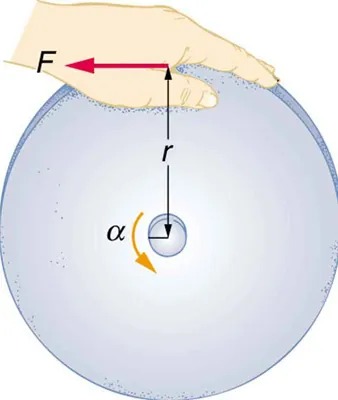
Figure 8.16 A large grindstone is given a spin by a person grasping its outer edge. Image from OpenStax College Physics 2e, CC-BY 4.0
Image Description
This image depicts a diagram illustrating the concept of torque. It shows a hand applying a force (F) tangentially to the edge of a circular disk. The force is represented by a red arrow pointing to the right. The center of the disk is marked, and there is a vertical line labeled r extending from the center to the edge, indicating the radius. An orange arrow curves around the center, labeled with the symbol α, representing angular acceleration. The overall setup visually explains how force applied at a distance from the pivot point causes rotational movement.
Solution for (b)
To find [latex]\omega[/latex] from the given information requires more than one step. We start with the kinematic relationship in the equation
[latex]\omega^{2} = \omega_{\text{0}}^{2} + 2 \alpha\theta .[/latex]
Note that [latex]\omega_{0} = 0[/latex] because we start from rest. Taking the square root of the resulting equation gives
[latex]\omega = \left(2 \alpha\theta\right)^{1 / 2} .[/latex]
Now we need to find [latex]\alpha[/latex]. One possibility is
[latex]\alpha = \frac{\text{net }\tau}{I} ,[/latex]
where the torque is
[latex]\text{net }\tau = \text{rF} = \left(\text{0}.\text{320 m}\right) \left(\text{200 N}\right) = \text{64}.\text{0 N} \cdot \text{m} .[/latex]
The formula for the moment of inertia for a disk is found in Figure 8.11:
[latex]\begin{align*}I &= \frac{1}{2} \text{MR}^{2}\\ &= 0.5 \left(\text{85}.\text{0 kg}\right) \left(\text{0}.\text{320 m}\right)^{2} \\ &= \text{4}.\text{352 kg} \cdot \text{m}^{2} .\end{align*}[/latex]
Substituting the values of torque and moment of inertia into the expression for [latex]\alpha[/latex], we obtain
[latex]\alpha = \frac{\text{64} . \text{0 N} \cdot \text{m}}{\text{4}.\text{352 kg} \cdot \text{m}^{2}} = \text{14}.\text{7} \frac{\text{rad}}{\text{s}^{2}} .[/latex]
Now, substitute this value and the given value for [latex]\theta[/latex] into the above expression for [latex]\omega[/latex]:
[latex]\begin{align*}\omega &= \left(2 \alpha\theta\right)^{1 / 2}\\ &= \left[2 \left(\text{14}.\text{7} \frac{\text{rad}}{\text{s}^{2}}\right) \left(\text{1}.\text{00 rad}\right)\right]^{1 / 2} \\ &= \text{5}.\text{42} \frac{\text{rad}}{\text{s}} .\end{align*}[/latex]
Solution for (c)
The final rotational kinetic energy is
[latex]\text{KE}_{\text{rot}} = \frac{1}{2} Iω^{2} .[/latex]
Both [latex]I[/latex] and [latex]\omega[/latex] were found above. Thus,
[latex]\begin{align*}\text{KE}_{\text{rot}} &= \left(0.5\right) \left(\text{4}.\text{352 kg} \cdot \text{m}^{2}\right) \left(\text{5}.\text{42 rad}/\text{s}\right)^{2} \\ &= \text{64}.\text{0 J} .\end{align*}[/latex]
Discussion
The final rotational kinetic energy equals the work done by the torque, which confirms that the work done went into rotational kinetic energy. We could, in fact, have used an expression for energy instead of a kinematic relation to solve part (b). We will do this in later examples.
Helicopter pilots are quite familiar with rotational kinetic energy. They know, for example, that a point of no return will be reached if they allow their blades to slow below a critical angular velocity during flight. The blades lose lift, and it is impossible to immediately get the blades spinning fast enough to regain it. Rotational kinetic energy must be supplied to the blades to get them to rotate faster, and enough energy cannot be supplied in time to avoid a crash. Because of weight limitations, helicopter engines are too small to supply both the energy needed for lift and to replenish the rotational kinetic energy of the blades once they have slowed down. The rotational kinetic energy is put into them before takeoff and must not be allowed to drop below this crucial level. One possible way to avoid a crash is to use the gravitational potential energy of the helicopter to replenish the rotational kinetic energy of the blades by losing altitude and aligning the blades so that the helicopter is spun up in the descent. Of course, if the helicopter’s altitude is too low, then there is insufficient time for the blade to regain lift before reaching the ground.
Problem-Solving Strategy for Rotational Energy
- Determine that energy or work is involved in the rotation.
- Determine the system of interest. A sketch usually helps.
- Analyze the situation to determine the types of work and energy involved.
- For closed systems, mechanical energy is conserved. That is, [latex]\text{KE}_{\text{i}} + \text{PE}_{\text{i}} = \text{KE}_{\text{f}} + \text{PE}_{\text{f}} .[/latex] Note that [latex]\text{KE}_{\text{i}}[/latex] and [latex]\text{KE}_{\text{f}}[/latex] may each include translational and rotational contributions.
- For open systems, mechanical energy may not be conserved, and other forms of energy (referred to previously as [latex]\text{OE}[/latex]), such as heat transfer, may enter or leave the system. Determine what they are, and calculate them as necessary.
- Eliminate terms wherever possible to simplify the algebra.
- Check the answer to see if it is reasonable.
Example 8.9
Calculating Helicopter Energies
A typical small rescue helicopter, similar to the one in Figure 8.17, has four blades, each is 4.00 m long and has a mass of 50.0 kg. The blades can be approximated as thin rods that rotate about one end of an axis perpendicular to their length. The helicopter has a total loaded mass of 1000 kg. (a) Calculate the rotational kinetic energy in the blades when they rotate at 300 rpm. (b) Calculate the translational kinetic energy of the helicopter when it flies at 20.0 m/s, and compare it with the rotational energy in the blades. (c) To what height could the helicopter be raised if all of the rotational kinetic energy could be used to lift it?
Strategy
Rotational and translational kinetic energies can be calculated from their definitions. The last part of the problem relates to the idea that energy can change form, in this case from rotational kinetic energy to gravitational potential energy.
Solution for (a)
The rotational kinetic energy is
[latex]\text{KE}_{\text{rot}} = \frac{1}{2} Iω^{2} .[/latex]
We must convert the angular velocity to radians per second and calculate the moment of inertia before we can find [latex]\text{KE}_{\text{rot}}[/latex]. The angular velocity [latex]\omega[/latex] is
[latex]\omega = \frac{\text{300 rev}}{\text{1}.\text{00 min}} \cdot \frac{\text{2}\pi\text{ rad}}{\text{1 rev}} \cdot \frac{\text{1}.\text{00 min}}{\text{60}.\text{0 s}} = \text{31}.\text{4} \frac{\text{rad}}{\text{s}} .[/latex]
The moment of inertia of one blade will be that of a thin rod rotated about its end, found in Figure 8.11. The total [latex]I[/latex] is four times this moment of inertia, because there are four blades. Thus,
[latex]I = 4 \frac{Mℓ^{2}}{3} = 4 \times \frac{\left(\text{50}.\text{0 kg}\right) \left(\text{4}.\text{00 m}\right)^{2}}{3} = \text{1067 kg} \cdot \text{m}^{2} .[/latex]
Entering [latex]\omega[/latex] and [latex]I[/latex] into the expression for rotational kinetic energy gives
[latex]\begin{eqnarray*}\text{KE}_{\text{rot}} & = & 0.5 \left(\right. \text{1067 kg} \cdot \text{m}^{2} \left.\right) \left(\text{31}.\text{4 rad}/\text{s}\right)^{2} \\ & = & 5.26 \times \text{10}^{5} \text{ J}\end{eqnarray*}[/latex]
Solution for (b)
Translational kinetic energy was defined in Uniform Circular Motion and Gravitation. Entering the given values of mass and velocity, we obtain
[latex]\begin{align*}\text{KE}_{\text{trans}} &= \frac{1}{2} \mathit{mv}^{2} \\ &= \left(0.5\right) \left(\text{1000 kg}\right) \left(\text{20}.\text{0 m}/\text{s}\right)^{2} \\ &= 2 . \text{00} \times \text{10}^{5} \text{ J} .\end{align*}[/latex]
To compare kinetic energies, we take the ratio of translational kinetic energy to rotational kinetic energy. This ratio is
[latex]\frac{2 . \text{00} \times \text{10}^{5} \text{ J}}{5 . \text{26} \times \text{10}^{5} \text{ J}} = 0.380 .[/latex]
Solution for (c)
At the maximum height, all rotational kinetic energy will have been converted to gravitational energy. To find this height, we equate those two energies:
[latex]\text{KE}_{\text{rot}} = \text{PE}_{\text{grav}}[/latex]
or
[latex]\frac{1}{2} Iω^{2} = \text{mgh} .[/latex]
We now solve for [latex]h[/latex] and substitute known values into the resulting equation
[latex]h = \frac{\left(\frac{1}{2} Iω\right)^{2}}{\text{mg}} = \frac{5.26 \times \text{10}^{5} \text{ J}}{\left(\text{1000 kg}\right) \left(9.80 \text{ m}/\text{s}^{2}\right)} = \text{53}.\text{7 m} .[/latex]
Discussion
The ratio of translational energy to rotational kinetic energy is only 0.380. This ratio tells us that most of the kinetic energy of the helicopter is in its spinning blades—something you probably would not suspect. The 53.7 m height to which the helicopter could be raised with the rotational kinetic energy is also impressive, again emphasizing the amount of rotational kinetic energy in the blades.
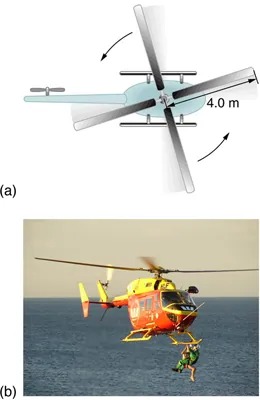
Figure 8.17 The first image shows how helicopters store large amounts of rotational kinetic energy in their blades. This energy must be put into the blades before takeoff and maintained until the end of the flight. The engines do not have enough power to simultaneously provide lift and put significant rotational energy into the blades. The second image shows a helicopter from the Auckland Westpac Rescue Helicopter Service. Over 50,000 lives have been saved since its operations beginning in 1973. Here, a water rescue operation is shown. Image from OpenStax College Physics 2e, CC-BY 4.0
Image Description
The image consists of two parts, labeled (a) and (b):
(a) This is a diagram of a helicopter rotor system. It shows a top view of the rotor blades, which are rotating counterclockwise. The rotor system includes four blades, each marked with a black arrow indicating the direction of rotation. A label indicates that the blades have a diameter of 4.0 meters.
(b) This is a photograph of a rescue helicopter in action over a body of water. The helicopter is yellow and red, with its side door open. A person wearing a harness is being lowered from the helicopter by a winch, descending towards the water. The ocean is calm, and the sky is clear, indicating a rescue operation is in progress.
Making Connections
Conservation of energy includes rotational motion, because rotational kinetic energy is another form of [latex]\text{KE}[/latex]. Uniform Circular Motion and Gravitation has a detailed treatment of conservation of energy.
How Thick Is the Soup? Or Why Don’t All Objects Roll Downhill at the Same Rate?
One of the quality controls in a tomato soup factory consists of rolling filled cans down a ramp. If they roll too fast, the soup is too thin. Why should cans of identical size and mass roll down an incline at different rates? And why should the thickest soup roll the slowest?
The easiest way to answer these questions is to consider energy. Suppose each can starts down the ramp from rest. Each can starting from rest means each starts with the same gravitational potential energy [latex]\text{PE}_{\text{grav}}[/latex], which is converted entirely to [latex]\text{KE}[/latex], provided each rolls without slipping. [latex]\text{KE}[/latex], however, can take the form of [latex]\text{KE}_{\text{trans}}[/latex] or [latex]\text{KE}_{\text{rot}}[/latex], and total [latex]\text{KE}[/latex] is the sum of the two. If a can rolls down a ramp, it puts part of its energy into rotation, leaving less for translation. Thus, the can goes slower than it would if it slid down. Furthermore, the thin soup does not rotate, whereas the thick soup does, because it sticks to the can. The thick soup thus puts more of the can’s original gravitational potential energy into rotation than the thin soup, and the can rolls more slowly, as seen in Figure 8.18.
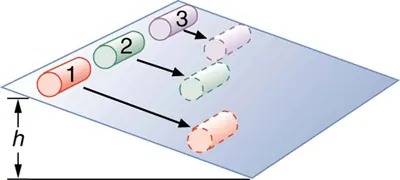
Figure 8.18 Three cans of soup with identical masses race down an incline. The first can has a low friction coating and does not roll but just slides down the incline. It wins because it converts its entire PE into translational KE. The second and third cans both roll down the incline without slipping. The second can contains thin soup and comes in second because part of its initial PE goes into rotating the can (but not the thin soup). The third can contains thick soup. It comes in third because the soup rotates along with the can, taking even more of the initial PE for rotational KE, leaving less for translational KE. Image from OpenStax College Physics 2e, CC-BY 4.0
Image Description
The image illustrates a sequence of three cylindrical objects moving across a surface. Each cylinder is numbered and has a corresponding colored outline:
- Cylinder 1: Positioned on the left, is red and filled in.
- Cylinder 2: Positioned in the middle, is green and filled in.
- Cylinder 3: Positioned on the right, is purple and filled in.
Each cylinder has an arrow pointing towards a faint, dashed outline of itself ahead on the surface, indicating movement in that direction. The outlines suggest the new positions of the cylinders along the plane.
The letter “h” with a bidirectional arrow indicates a vertical measurement from the surface, denoting height or separation distance from another reference point not visible in this image.
Assuming no losses due to friction, there is only one force doing work—gravity. Therefore the total work done is the change in kinetic energy. As the cans start moving, the potential energy is changing into kinetic energy. Conservation of energy gives
[latex]\text{PE}_{\text{i}} = \text{KE}_{\text{f}} .[/latex]
More specifically,
[latex]\text{PE}_{\text{grav}} = \text{KE}_{\text{trans}} + \text{KE}_{\text{rot}}[/latex]
or
[latex]\text{mgh} = \frac{1}{2} \text{mv}^{2} + \frac{1}{2} Iω^{2} .[/latex]
So, the initial [latex]\text{mgh}[/latex] is divided between translational kinetic energy and rotational kinetic energy; and the greater [latex]I[/latex] is, the less energy goes into translation. If the can slides down without friction, then [latex]\omega = 0[/latex] and all the energy goes into translation; thus, the can goes faster.
Take-Home Experiment
Locate several cans each containing different types of food. First, predict which can will win the race down an inclined plane and explain why. See if your prediction is correct. You could also do this experiment by collecting several empty cylindrical containers of the same size and filling them with different materials such as wet or dry sand.
Example 8.10
Calculating the Speed of a Cylinder Rolling Down an Incline
Calculate the final speed of a solid cylinder that rolls down a 2.00-m-high incline. The cylinder starts from rest, has a mass of 0.750 kg, and has a radius of 4.00 cm.
Strategy
We can solve for the final velocity using conservation of energy, but we must first express rotational quantities in terms of translational quantities to end up with [latex]v[/latex] as the only unknown.
Solution
Conservation of energy for this situation is written as described above:
[latex]\text{mgh} = \frac{1}{2} \mathit{mv}^{2} + \frac{1}{2} Iω^{2} .[/latex]
Before we can solve for [latex]v[/latex] , we must get an expression for [latex]I[/latex] from Figure 8.11. Because [latex]v[/latex] and [latex]\omega[/latex] are related (note here that the cylinder is rolling without slipping), we must also substitute the relationship [latex]\omega = v / R[/latex] into the expression. These substitutions yield
[latex]\text{mgh} = \frac{1}{2} \mathit{mv}^{2} + \frac{1}{2} \left(\frac{1}{2} \mathit{mR}^{2}\right) \left(\frac{v^{2}}{R^{2}}\right) .[/latex]
Interestingly, the cylinder’s radius [latex]R[/latex] and mass [latex]m[/latex] cancel, yielding
[latex]\text{gh} = \frac{1}{2} v^{2} + \frac{1}{4} v^{2} = \frac{3}{4} v^{2} .[/latex]
Solving algebraically, the equation for the final velocity [latex]v[/latex] gives
[latex]v = \left(\frac{4 \text{gh}}{3}\right)^{1 / 2} .[/latex]
Substituting known values into the resulting expression yields
[latex]v = \left[\frac{4 \left(9.80 \text{ m}/\text{s}^{2}\right) \left(\text{2}.\text{00 m}\right)}{3}\right]^{1 / 2} = \text{5}.\text{11 m}/\text{s} .[/latex]
Discussion
Because [latex]m[/latex] and [latex]R[/latex] cancel, the result [latex]v = \left(\frac{4}{3} \text{gh}\right)^{1 / 2}[/latex] is valid for any solid cylinder, implying that all solid cylinders will roll down an incline at the same rate independent of their masses and sizes. (Rolling cylinders down inclines is what Galileo actually did to show that objects fall at the same rate independent of mass.) Note that if the cylinder slid without friction down the incline without rolling, then the entire gravitational potential energy would go into translational kinetic energy. Thus, [latex]\frac{1}{2} \text{mv}^{2} = \text{mgh}[/latex] and [latex]v = \left(\right. 2 \text{gh} \left.\right)^{1 / 2}[/latex], which is 22% greater than [latex]\left(\right. 4 \text{gh} / 3 \left.\right)^{1 / 2}[/latex]. That is, the cylinder would go faster at the bottom.
Check Your Understanding
Analogy of Rotational and Translational Kinetic EnergyIs rotational kinetic energy completely analogous to translational kinetic energy? What, if any, are their differences? Give an example of each type of kinetic energy.
Click for Solution
Solution
Yes, rotational and translational kinetic energy are exact analogs. They both are the energy of motion involved with the coordinated (non-random) movement of mass relative to some reference frame. The only difference between rotational and translational kinetic energy is that translational is straight line motion while rotational is not. An example of both kinetic and translational kinetic energy is found in a bike tire while being ridden down a bike path. The rotational motion of the tire means it has rotational kinetic energy while the movement of the bike along the path means the tire also has translational kinetic energy. If you were to lift the front wheel of the bike and spin it while the bike is stationary, then the wheel would have only rotational kinetic energy relative to the Earth.

